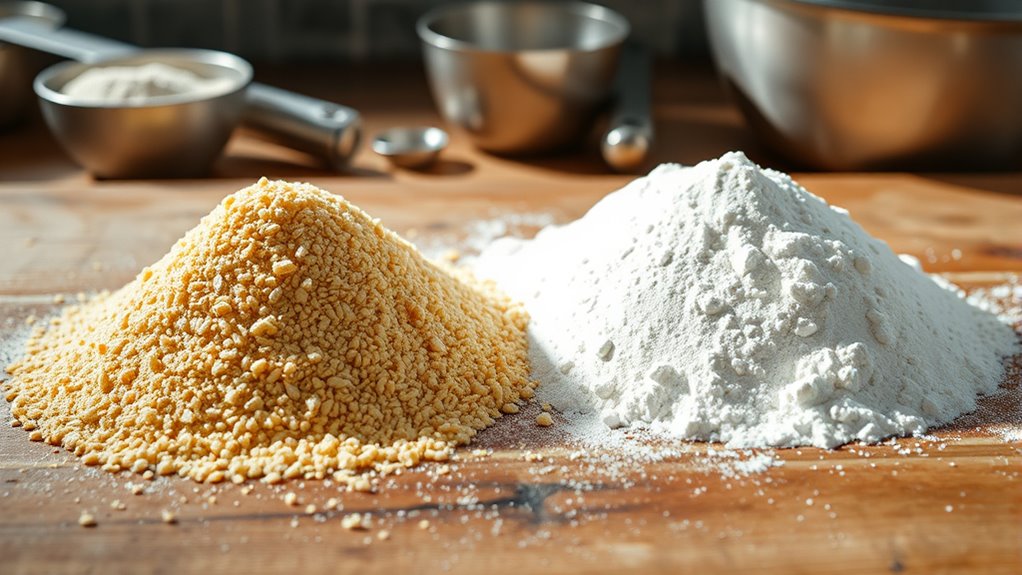To master semolina versus flour in a weekend, start by understanding their key differences: semolina is coarser, made from durum wheat, and best for pasta or hearty baked goods, while flour is finer and versatile for many recipes. Experiment with textures, hydration, and gluten development for various dishes. Pay attention to storage and troubleshooting common issues like sticking or tearing. Keep practicing, and you’ll gain confidence—continuing will open even more tips and techniques to elevate your skills.
Key Takeaways
- Study the fundamental differences between semolina and flour, focusing on grain type, texture, and common culinary uses.
- Practice preparing and cooking with both ingredients to understand their impact on texture, flavor, and gluten development.
- Experiment with recipes combining semolina and flour to master their unique properties and achieve desired results.
- Observe proper storage, handling, and ingredient quality to ensure consistent, high-quality outcomes in your baking.
- Balance theoretical knowledge with hands-on practice, scheduling dedicated time over the weekend to refine techniques and build confidence.
Understanding the Basic Differences Between Semolina and Flour
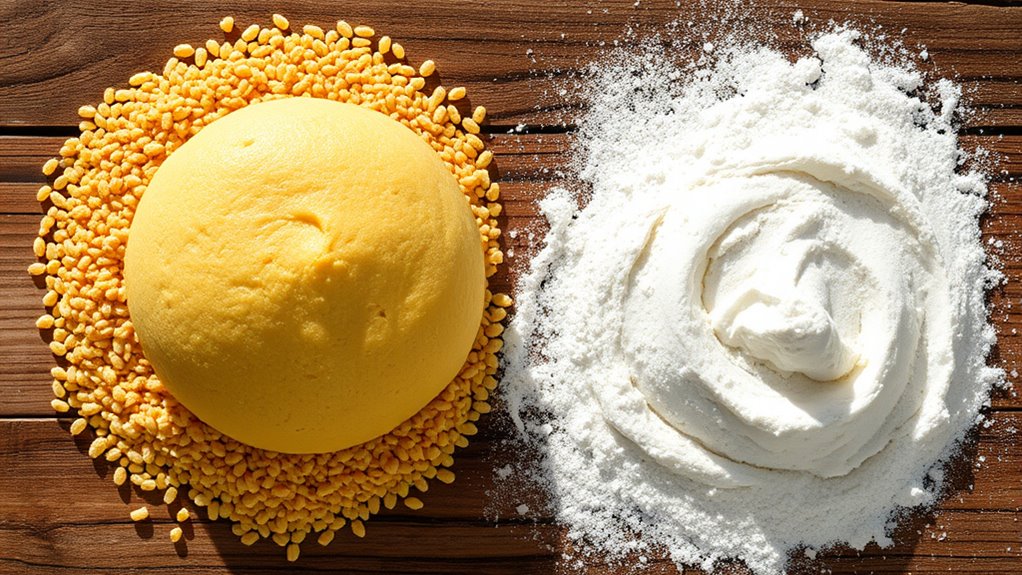
Have you ever wondered what sets semolina apart from regular flour? It all begins with grain milling and ingredient sourcing. Semolina is made from durum wheat, which is milled to produce coarse, yellowish grains. Regular flour typically comes from soft wheat, ground into fine powder through a different milling process. The grain milling process influences the texture and color, with semolina’s coarse grind giving it a gritty feel, ideal for pasta and certain baked goods. Ingredient sourcing also matters; durum wheat’s high protein content makes semolina more resilient to cooking, giving your dishes a firm bite. In contrast, softer wheat varieties used for flour create a lighter, softer texture. Understanding these foundational differences helps you choose the right ingredient for your culinary needs. Additionally, the milling process impacts the final texture and quality of the flour or semolina, making it an essential factor in selecting the appropriate ingredient.
Selecting the Right Type of Flour for Your Project
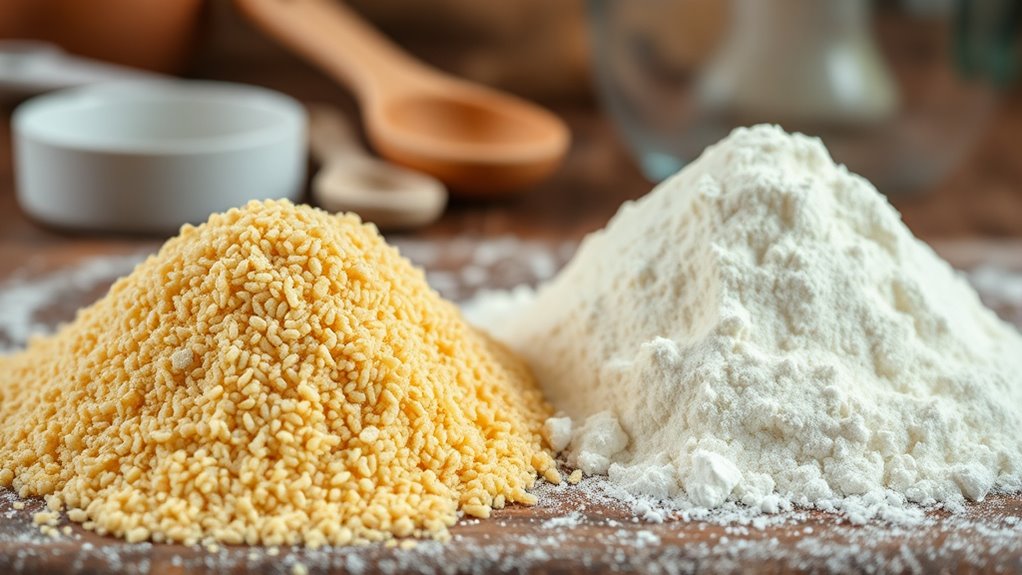
Choosing the right flour depends on the grain’s characteristics and how you’ll use it. You’ll want to take into account the gluten content, which affects the dough’s texture and elasticity. Knowing these factors helps guarantee your project turns out just right. For example, selecting a bedroom design style that complements your decor can enhance the overall ambiance of your space.
Grain Characteristics and Uses
Understanding the distinct characteristics of semolina and flour is essential for selecting the right ingredient for your project. Semolina, made from durum wheat, has a coarse texture and high protein content, ideal for pasta and sturdy baked goods. Regular flour, usually milled from soft wheat, is finer and more versatile, suited for cakes, pastries, and bread. Grain storage plays a role in maintaining freshness; semolina’s coarse grains store well, while flour’s fine particles need proper sealing to prevent spoilage. Milling processes differ: semolina undergoes a more rigorous milling to produce coarse particles, whereas flour is ground more finely. Knowing these grain characteristics helps you match the ingredient’s texture and strength with your recipe needs, ensuring your project turns out just right. Proper storage methods also help preserve the grain’s quality, ensuring optimal performance in your baking endeavors.
Gluten Content and Texture
The gluten content in flour considerably influences its texture and how it performs in different recipes. Higher gluten levels promote better gluten development, which is essential for achieving strong dough elasticity. This means you’ll get a more resilient, stretchable dough that holds its shape well. Conversely, low-gluten flours create softer, tender textures, perfect for pastries and cakes. Embracing creative practice can help you experiment with different flour types and discover new textures and flavors in your baking. Choose your flour based on your project: – Use bread flour for chewy, elastic bread dough – Opt for all-purpose for versatility – Select cake flour for delicate, tender baked goods – Semolina offers moderate gluten, ideal for pasta – Whole wheat provides more fiber but less gluten development Matching the gluten content with your recipe ensures ideal texture and structure every time.
Exploring the Unique Uses of Semolina in Cooking and Baking
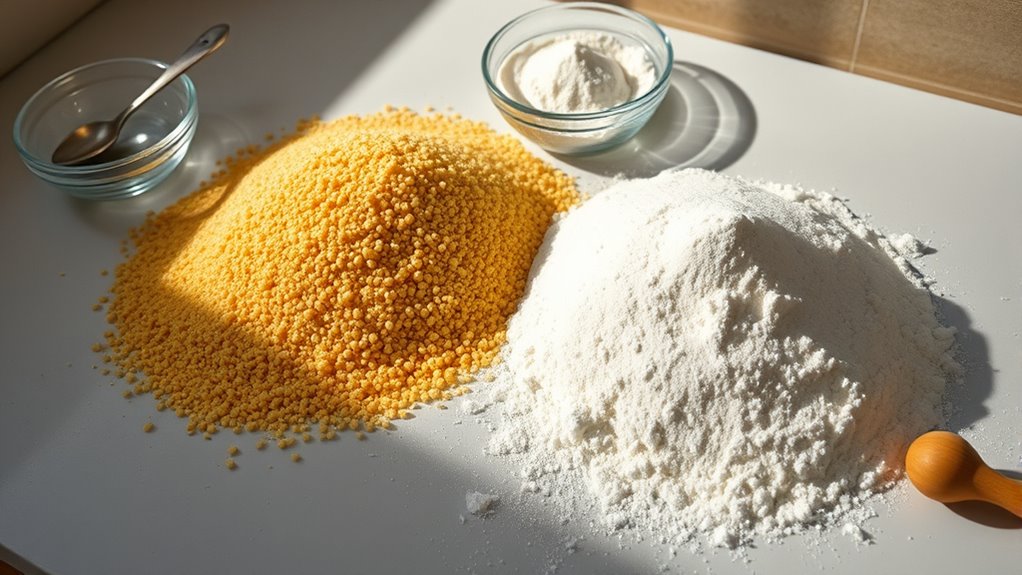
Semolina is a versatile ingredient that transforms your cooking and baking. You can craft traditional pasta with a firm texture, create crispy snacks, or make rich puddings that satisfy sweet cravings. Exploring these uses will help you unlock semolina’s full potential in your kitchen.
Traditional Pasta Making
When making traditional pasta, semolina stands out as the ideal choice because of its coarse texture and high gluten content, which give pasta its firmness and chewiness. To achieve perfect gluten development, you should focus on proper hydration techniques, gradually adding water while kneading. This ensures the semolina absorbs moisture evenly, creating a resilient dough.
Consider these tips:
- Use a fork or your hands to mix, preventing overworking the dough.
- Rest the dough for at least 30 minutes to improve elasticity.
- Knead thoroughly to develop gluten without breaking the grains.
- Keep the dough covered to prevent drying out during hydration.
- Roll out evenly for consistent texture and thickness.
Mastering these steps results in pasta with ideal bite and structure, making your homemade dish truly exceptional.
Crispy Semolina Snacks
After mastering traditional pasta making with semolina, you can explore its versatility in creating crispy snacks that add texture and flavor to your culinary repertoire. Semolina’s coarse grains turn into golden, crunchy treats like crispy sev or crunchy snack sticks, perfect for snacking or garnishing dishes. These snacks pair well with semolina desserts, offering a satisfying crunch that complements their sweetness. You can also incorporate semolina into flour-based sauces for a unique twist, adding a subtle nuttiness and crispiness when fried. Using semolina in snacks not only enhances texture but also showcases its ability to stand out in savory and sweet applications. Additionally, understanding the best anime movies and animated films that touch hearts can inspire creative presentation styles and storytelling techniques when experimenting with new recipes. Experimenting with these crispy treats broadens your understanding of semolina’s potential beyond traditional uses.
Rich Pudding Variations
Rich pudding variations showcase semolina’s ability to create smooth, creamy desserts with a hearty texture. You can craft a variety of semolina desserts that stand out from traditional flour-based custards. Try a classic semolina pudding topped with nuts and honey for added richness. Experiment with flavors by adding cardamom, saffron, or citrus zest to enhance your dessert. Semolina pudding can be layered with fruit compotes or swirled with chocolate for extra indulgence. These rich pudding variations highlight semolina’s versatility, offering a unique twist on familiar flour-based custards. Incorporating Aesthetic Table Linen can elevate the presentation of your dessert, making it perfect for special occasions or festive gatherings. Whether served warm or chilled, semolina desserts bring a comforting, hearty flavor that’s ideal for everyday treats. Explore these options and elevate your dessert game effortlessly.
Comparing Texture and Grain Size: What Matters Most?
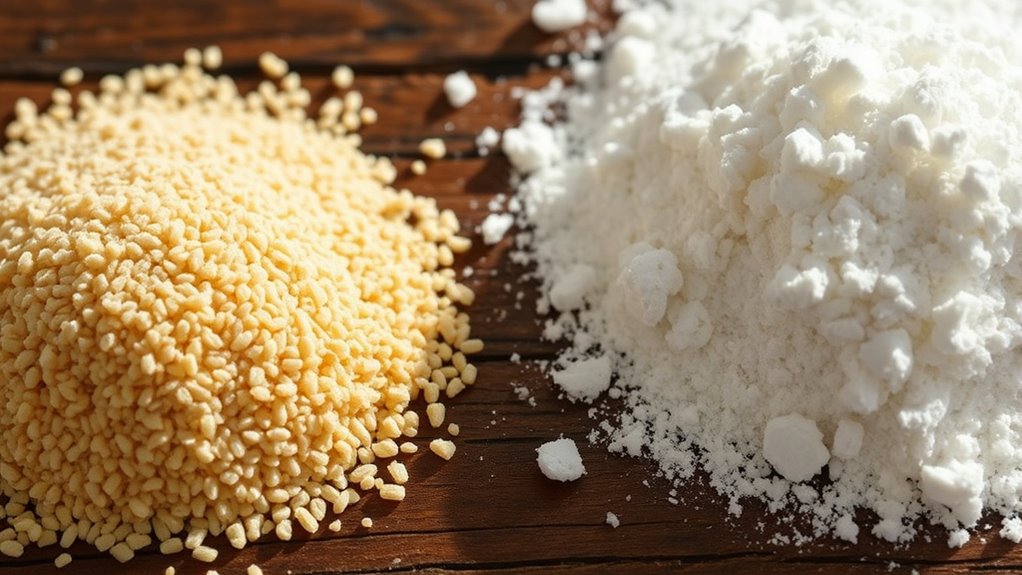
Texture and grain size play a crucial role in determining how semolina and flour perform in your recipes. Grain size influences the consistency and firmness of your final product. Semolina has a coarse, gritty texture, making it ideal for pasta and doughs that need structure. Flour, on the other hand, has a finer, smoother grain, resulting in softer baked goods like cakes and pastries. These texture differences directly impact the dough’s elasticity and the dish’s mouthfeel. When choosing between them, consider what you want in your finished product: coarser semolina provides a hearty bite, while finer flour creates a tender crumb. Understanding these texture distinctions helps you select the right ingredient for perfect results every time. Additionally, nutritional information can vary between semolina and flour, affecting your overall dietary goals.
Analyzing Nutritional Profiles of Semolina and Flour
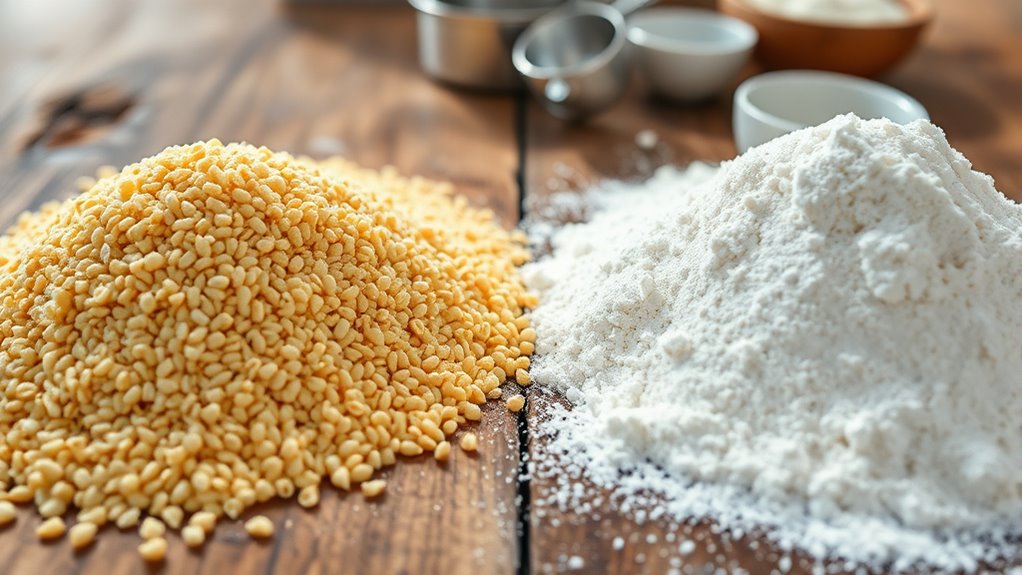
Understanding the nutritional differences between semolina and flour can help you make healthier choices in your cooking. Semolina, made from durum wheat, generally has a higher protein and fiber content, boosting its nutritional value. Flour, especially refined types, tends to be lower in fiber but can be enriched with nutrients. Here are some key points to contemplate:
- Semolina offers more protein, supporting muscle health.
- Whole wheat flour provides added fiber for digestion.
- Semolina is often richer in iron and magnesium.
- Refined flour may have fewer nutrients but is versatile.
- Both can be part of a balanced diet, depending on your health goals.
- Seasonal variations in availability and quality can influence your choice of ingredients.
Knowing these differences lets you select ingredients that maximize health benefits while satisfying your culinary needs.
Practical Techniques for Preparing Semolina and Flour
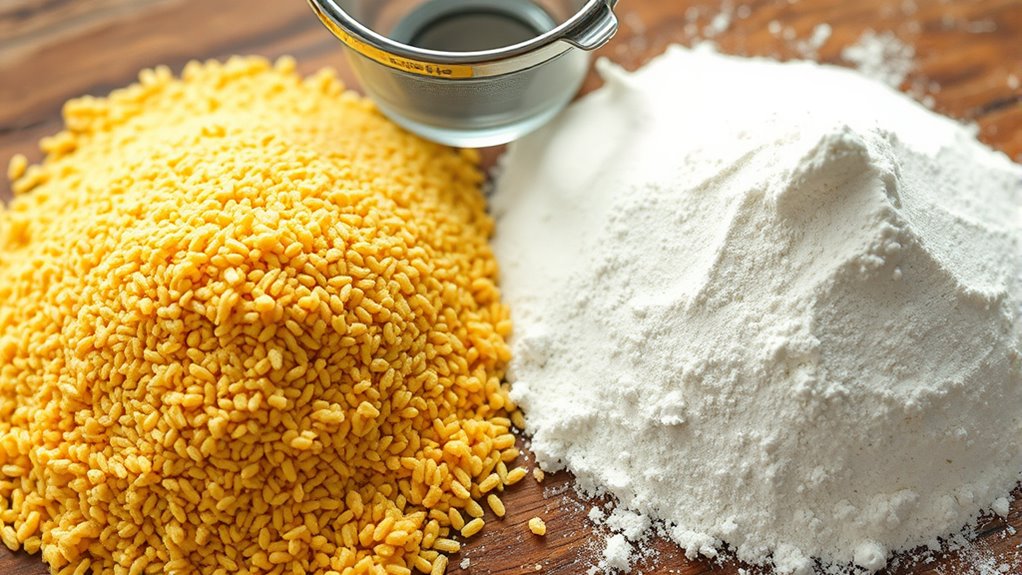
Preparing semolina and flour properly can greatly enhance your cooking results. To do this, focus on grain milling techniques that preserve the integrity of each ingredient. When sourcing ingredients, choose high-quality grains from reputable suppliers to ensure freshness and consistency. For semolina, opt for durum wheat that’s milled specifically for coarse particles, ideal for pasta and certain baked goods. Flour, on the other hand, benefits from fine milling, which produces a smooth texture perfect for bread and pastries. Before use, sift your ingredients to remove any impurities and achieve even consistency. Proper storage is also essential; keep your semolina and flour in airtight containers away from moisture and direct sunlight. Additionally, understanding the fundamentals of SQA can help ensure your baking process maintains consistent quality and standards. These practical steps lay a solid foundation for mastering your recipes.
Experimenting With Recipes: Pasta, Bread, and More
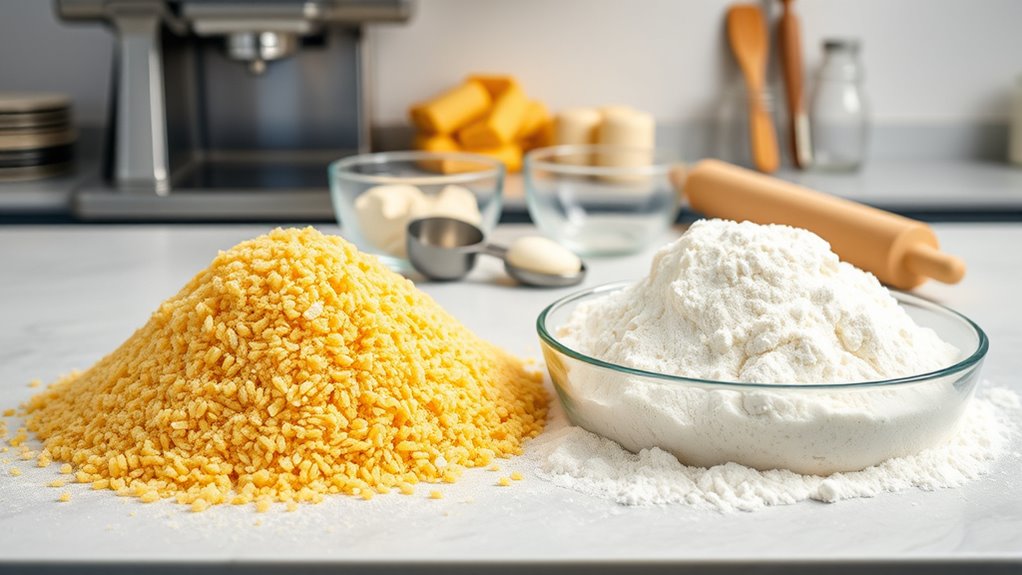
Once you’ve mastered the basics of preparing semolina and flour, it’s time to get creative by experimenting with different recipes. You’ll notice how grain texture influences the dough’s feel, affecting pasta elasticity or bread crumb structure. Play with flavor profiles by combining ingredients like herbs, spices, or even roasted vegetables into your dough. Here are some ideas to try:
- Making fresh pasta with semolina for a firmer bite
- Baking rustic bread that highlights the nutty flavor of whole wheat flour
- Creating flatbreads infused with herbs and garlic
- Crafting sweet semolina cakes with a tender crumb
- Testing different hydration levels to adjust texture and taste
Experimenting allows you to discover how grain texture and flavor profiles influence your finished product, elevating your culinary skills. Understanding how AI integration can enhance kitchen appliances and recipe customization is also an exciting frontier for modern cooking.
Troubleshooting Common Issues When Using Semolina and Flour
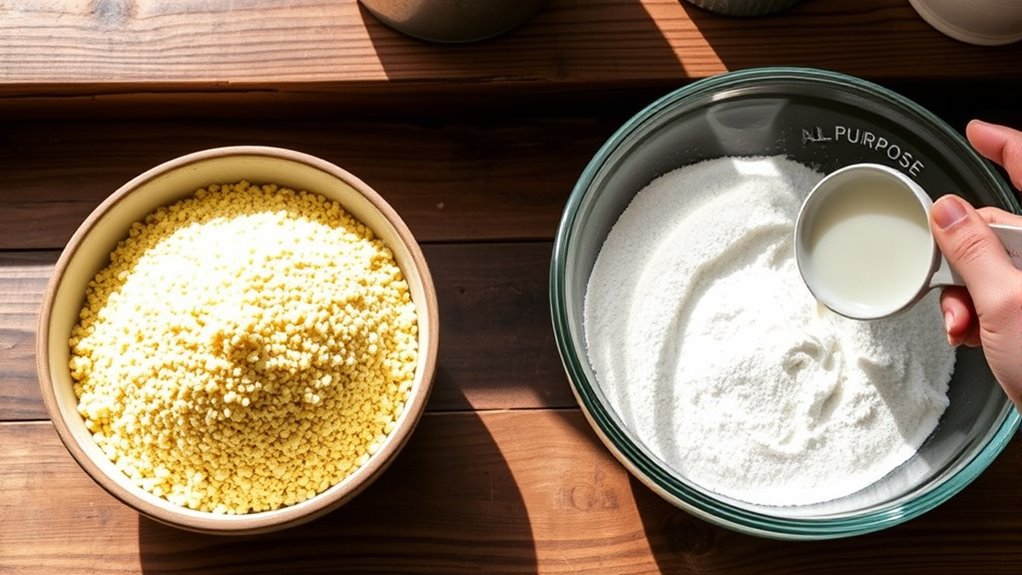
When working with semolina and flour, issues like dough sticking, tearing, or not rising properly can arise if you’re not careful. These problems often stem from texture variations or improper hydration. To troubleshoot, consider adjusting water amounts or kneading time. Recognize flavor differences; semolina tends to have a nutty taste, while flour offers a milder flavor, affecting your recipe’s outcome.
| Issue | Solution |
|---|---|
| Dough sticking | Add a small amount of flour or semolina gradually |
| Tearing during kneading | Rest the dough briefly, then re-knead lightly |
| Poor rising | Check yeast freshness, ensure proper proofing |
Tips for Storing and Preserving Your Ingredients
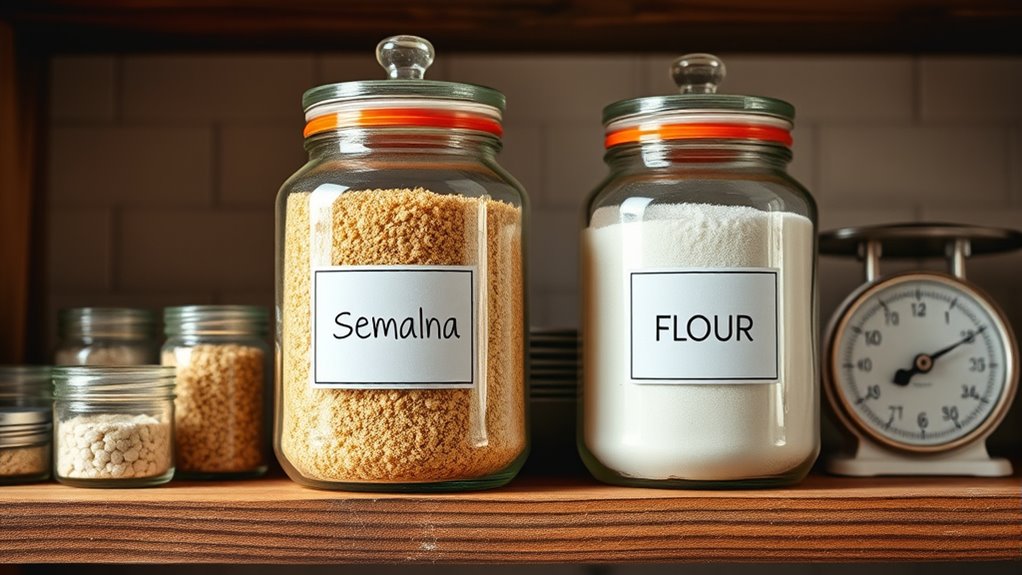
Choosing the right containers helps maintain your semolina and flour fresh longer. Store them in cool, dark places to prevent spoilage, and watch for signs that they’ve reached their shelf life. Proper storage ensures your ingredients stay quality-ready whenever you need them.
Proper Container Selection
Selecting the right container is essential for keeping semolina and flour fresh and free from contamination. Proper containers protect your ingredients from moisture, pests, and exposure to air, preserving their quality. When choosing, consider containers made of airtight, food-grade materials that prevent spoilage. Clear containers help you monitor quantities easily, reducing waste. Look for options that are stackable and space-efficient for convenient storage. Always source your containers from reputable suppliers to ensure durability and safety, just like with your grain milling and ingredient sourcing. Proper containers keep your ingredients fresh longer, ensuring your baking results remain consistent and high-quality. Remember, investing in good storage solutions is a critical step in mastering your semolina versus flour for a successful weekend launch.
Ideal Storage Conditions
To keep your semolina and flour fresh and flavorful, maintaining ideal storage conditions is essential. Proper storage begins with quality grain milling and careful ingredient sourcing, ensuring you start with clean, uncontaminated products. Store your ingredients in airtight containers that protect them from moisture, air, and pests. Keep them in a cool, dark place away from direct sunlight and heat, which can accelerate spoilage. Consistent temperatures help preserve the texture and flavor, preventing rancidity or clumping. Avoid frequent exposure to humidity or temperature fluctuations. Label your containers with purchase dates to track freshness. By following these storage tips, you ensure your semolina and flour stay at their best, ready for flawless cooking and baking whenever you need them.
Shelf Life Indicators
Understanding the shelf life of your semolina and flour is key to maintaining their quality and safety. Properly evaluating shelf life indicators helps you know when ingredients are still good to use. Look out for changes such as off-odor, discoloration, or clumping, which signal spoilage. Store your ingredients in airtight containers to prevent exposure to moisture and pests. Keep them in cool, dark places to slow deterioration. Regularly check for signs of rancidity or mold. Remember, preservation techniques like freezing can extend shelf life for longer storage periods. Staying vigilant ensures your ingredients remain fresh and safe for your recipes. By paying attention to these shelf life indicators, you avoid waste and guarantee the best results every time.
Planning Your Weekend Schedule for Effective Learning and Practice

Since weekends often provide the most flexible time for focused learning and practice, planning your schedule carefully can make a significant difference in mastering semolina and flour techniques. Allocate specific blocks of time for hands-on practice, focusing on dough elasticity and fermentation techniques. Start with short sessions to build confidence, then gradually increase the duration as you gain familiarity. Include time for reviewing your results, adjusting your approach, and experimenting with different ingredients. Be sure to balance theory with practical application, so you understand how fermentation impacts dough rise and texture. By organizing your weekend effectively, you ensure consistent progress and avoid rushing through essential steps, making your learning experience both efficient and rewarding.
Frequently Asked Questions
How Can I Tell if My Semolina and Flour Are Fresh?
To check if your semolina and flour are fresh, look for freshness indicators like a mild aroma and a smooth texture without clumps or discoloration. Store them in airtight containers in a cool, dark place to maintain freshness longer. If they smell sour or off, or if you see mold, discard them. Regularly rotating your stock and using within a few months helps guarantee you’re always working with fresh ingredients.
Are There Gluten-Free Alternatives for Semolina and Flour?
You might worry that gluten-free grains can’t replace semolina or flour, but many alternative flours work perfectly. Try options like rice, almond, or chickpea flour for baking or cooking. These gluten-free grains provide different textures and flavors, yet still give you great results. So, yes, there are plenty of delicious gluten-free alternatives, making it easy to adapt your recipes without sacrificing taste or quality.
What Equipment Is Essential for Working With Semolina and Flour?
You’ll need essential tools like a good quality sieve, rolling pin, and mixing bowls to work with semolina and flour efficiently. A digital scale guarantees precise measurements, and a sturdy storage container keeps your ingredients fresh. Invest in airtight storage solutions to prevent moisture and pests, and consider a stand mixer if you plan to make large batches. These tools help streamline your process and keep your workspace organized.
How Do Humidity and Climate Affect Ingredient Quality?
A stitch in time saves nine, and when it comes to ingredient quality, humidity and climate can make or break your efforts. You should prioritize proper grain storage and climate control to prevent moisture absorption, which can lead to spoilage or clumping. Keep your flour and semolina in airtight containers, store them in a cool, dry place, and monitor humidity levels regularly to maintain freshness and consistency in your products.
Can I Substitute Semolina for Flour in All Recipes?
You can substitute semolina for flour in some recipes, but it’s not a one-to-one replacement. Semolina adds a distinct texture and flavor, making it ideal for pasta or bread, but it may alter the outcome in baked goods. For broader flour alternatives, consider whole wheat or gluten-free options. Always test small batches first to see how semolina substitution affects your dish’s texture and taste.
Conclusion
By understanding the differences between semolina and flour, you discover a world of culinary possibilities. Think of them as two sides of the same coin—each with its own purpose and charm. With your newfound knowledge, you’re ready to master your weekend projects and elevate your cooking game. So, why not turn this learning into a delicious adventure? After all, the secret ingredient to success is simply your willingness to try.
